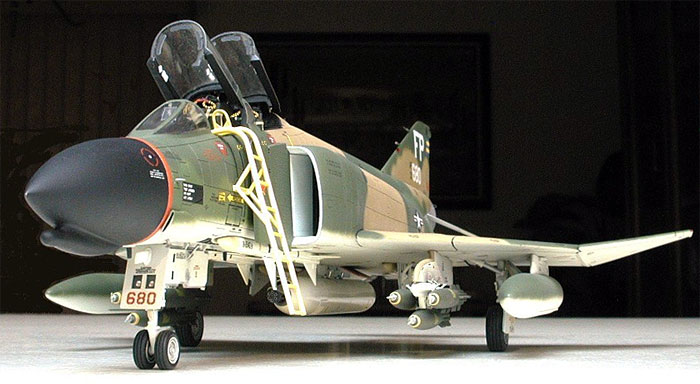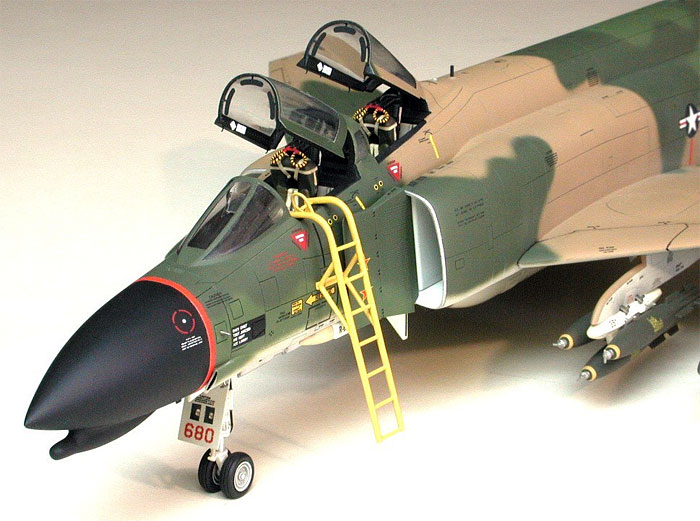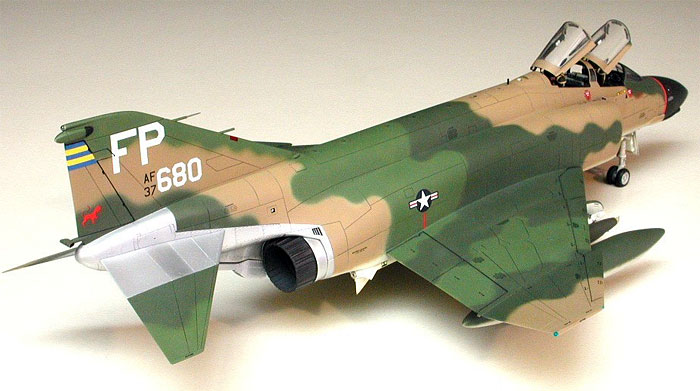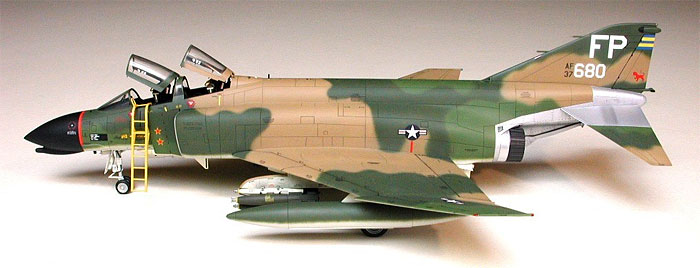|
Hasegawa's
original 1/48 scale
F-4C Phantom II
by
Roger Jackson
|
 |
|
McDonnell-Douglas F-4C Phantom II |

HyperScale is proudly supported by Squadron
Presented here is my recently completed Hasegawa F-4C in
1:48th scale. I performed some corrections and updates to make the model
a bit more contemporary in terms of detailing and appearance.
This is the original P6 boxing first released in 1984 so I rescribed the
entire model for visual compatibility with my other Hasegawa F-4s that
all have recessed surface detail. Corrections included relocating the
hinge pins for the horizontal stabilators, replacing the undersized
inboard pylons, and rebuilding the secondary nose gear door to the
proper configuration.
Additional details were added to the landing gear, pylons, tailpipes,
and cockpit. I used ordnance from the various Hasegawa weapons sets to
represent an aircraft configured for a strike or close air support
mission. The Aero 3B centerline pylon mounting the gun pod came from
Monogram's F-4C kit, which also provided the main landing gear doors.

The oversimplified nose landing gear strut was rebuilt with a proper
slave cylinder and hydraulic lines since the standard-issue kit part
looks pretty two-dimensional right out of the box. Common straight pins
became a new AOA transducer and outside air temperature probe after some
modest reworking. The boarding ladder is a "bonus" piece from Hasegawa's
later F-4E kit.
I gave the cockpit some attention by adding some details to the seats,
instrument panels, and side consoles. One shortcoming of all Phantom
kits is the lack of any substance to the canopy rails and rear
stiffeners. Those who have ever flown this ship or sat in a cockpit at
an open house will understand. I used some Plastruct "L" shape to create
the perpendicular rails then detailed the rear bows with Evergreen
sheet.

The now-OOP Model Technologies photo-etched canopy detail set, jet
mirrors, and seat buckle sets were used to finish out the interior, then
I added the placards for radio frequencies, transponder codes, and other
flight data to the inside of the canopy rails using bits of .010"
plastic sheet.
The paints are my custom "re-blends" using Model Master
enamels as a starting point.
I pre-shaded the panel lines with flat black then
sprayed the camo colors freehand after first drawing the pattern lightly
on the model with an HB drafting pencil. I kept the weathering to a
minimum, using only a Payne's Gray watercolor wash in the control
surface hinge lines and the recessed BLC vents on the intake ducts.
Various Model Master Metallizer shades were used on the aft fuselage and
stabilators to simulate the unpainted areas, while Rub 'N' Buff silver
was used on the tailpipes along with flat black paint burnished with
powdered graphite to create the two-tone effect.

The decals came from a variety of sources since no one single
commercially-available sheet had the all the correct markings and
insignia I needed. I decided to rely on the memories of several
maintenance troops who serviced these particular aircraft during their
tours in Thailand since much of what passes for research among some
decal companies has been proven to be erroneous.
Thus, the model as marked represents F-4C 63-7680 which was flown by
Colonel Robin Olds on 2 January 1967 during "Operation Bolo" when he and
weapons system operator 1st Lieutenant Charles Clifton claimed a MiG-17.
The loadout is not representational of that event however. I chose to
depict the aircraft later, as fragged for an air-to-ground sortie.
Many of these early F-4Cs were originally deployed from the US in their
original pre-war Gull Gray over Gloss White paint scheme and they were
literally covered with service stenciling. Camouflage colors were
hastily applied to these aircraft, sometimes in Thailand and sometimes
at Clark AFB in the Philippines. Regardless of location, the myriad of
stenciling was never replaced when the ships received their warpaint;
only the basic emergency egress information, pyrotechnic warnings, and
ground crew hazard markings were re-applied, and only as time permitted.

The missiles, bombs, and pylons were decaled with a modest amount of
stencils since my research indicated that these items were invariably
embellished with data. Also the pylons were always serialized to a
specific aircraft, with the ship's "last three" applied to both sides of
the pylon, sometimes using vinyl peel-and-stick numerals.
I always seem to have a Phantom kit in progress, buried somewhere on my
bench -- this one took me only fourteen years to finish. Look for a
full-length feature article about this model to appear in a future issue
of "Aerospace Modeler Magazine".
I hope y'all enjoyed it......MODEL ON!
Roger Jackson
IPMS 43070
Click the thumbnails below to view larger images:
Model, Images and Text Copyright © 2006
by Roger Jackson
Page Created 01 December, 2006
Last Updated
21 February, 2007
Back to
HyperScale Main Page
|
Home
| What's New |
Features |
Gallery |
Reviews |
Reference |
Forum |
Search